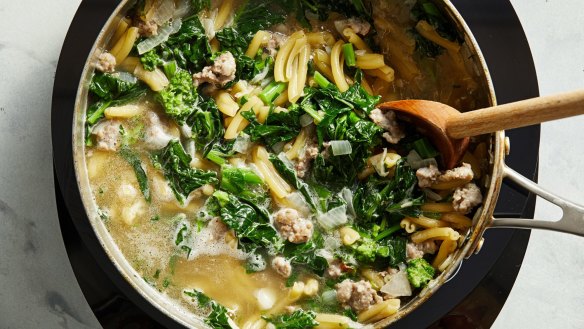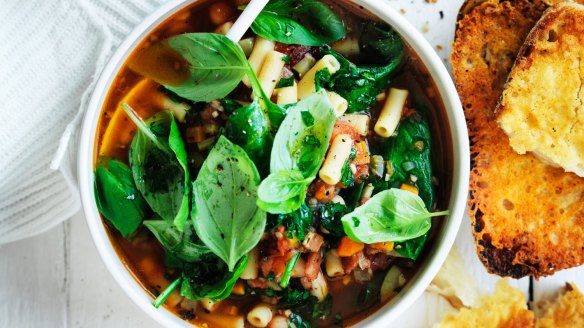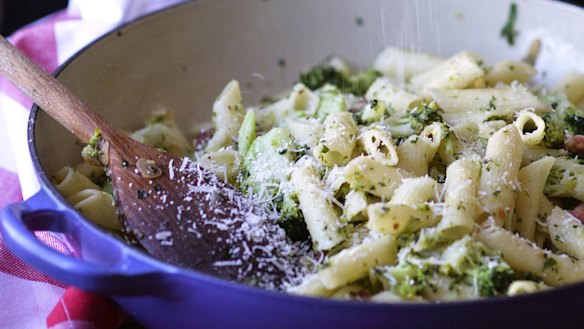How to make cheap and tasty one-pot pasta wonders

Contrary to cliche, a watched pot will in fact boil. Eventually. But I'd say it ranks up there with watching paint dry and grass grow in terms of riveting entertainment. Plus, when you want to make pasta on a weeknight, who has time to sit around waiting for the water? And surely I'm not the only one who hates having to pour all that water down the sink or lug it out to the garden.
The good news is you don't need a whole pot of water to cook pasta. The even better news is that you can make your whole pasta dinner in a single pot or saucepan. It's the perfect kind of improvised meal that can save you time and effort, while also cutting back on your food waste.
What you get is an all-in-one dish complete with built-in sauce. And before all the "authentic" police come after me for saying this is not how it's done in Italy, let me say this: It is. Rome-based food writer and cookbook author Katie Parla notes that there are "a variety of dishes and traditions that feature cooking the pasta in the sauce without boiling and draining it first". Much of it leans toward a brothier pasta, often mixed with a starchy bean liquid.
Still, there's room for interpretation whether you like to eat your pasta with a spoon or fork (or both?). Here are some tips for putting a satisfying one-pot (or pan) pasta on your table.
Cooking pasta in less water will not adversely affect it.

As Serious Eats explains in one of its characteristic deep dives, your pasta won't overcook or stick together, although you can stir occasionally as extra insurance. Plus, with a lower volume, you'll get more concentrated starch in the water. That gives you the start of a sauce to coat the pasta.
The technique is fairly adaptable in terms of cooking vessels. For a few servings, a frypan is fine. A larger saucepan or pot can accommodate more.
Choose short shapes

Chef Michael Schlow recommends keeping the pasta in this type of dish small. Think penne, orecchiette, mezzi rigatoni, ditalini and small shells. This is one of the only times when it's okay to break your spaghetti, says Parla. If you have several boxes of pasta with just a little left in each, she says you can feel free to combine them, provided their cooking time is about the same.
Build your flavours
A classic Italian formulation would be to start the dish with a soffritto – a combination of onion, olive oil, celery and carrot – Parla says. The idea is to start a foundation that will carry through the entire dish. I found that thinly sliced garlic worked well in the mix. If you like, you can saute meat first, and use that fat to cook your aromatics. Keep in mind that if you plan to keep the meat in for the whole cooking time, you may not want to render out all the fat at once, especially if it's lean. Other meaty options Parla likes are small squares of guanciale or pancetta. She advises salting as you add each layer of ingredients, with one last adjustment at the end.
Don't be afraid to use up less-than-perfect food
The leaves from the celery? In they go. That iffy last little bit of parsley? Go for it. Whether it's one lone anchovy or the very end of a tube of tomato paste, you can browse your fridge for little pops of flavour. At the end of cooking, a glug of extra-virgin olive oil, a pinch of chilli flakes or a drizzle of chilli oil can work wonders, too.
Round out the dish
Here's where you can have just as much fun. Parla says beans are a natural fit, and Italians are more than happy to include potatoes or peas, too. Schlow's inclinations lead toward greens, such as Brussels sprouts leaves, kale and broccoli (which was blanched first to begin the cooking process).
Be sure you think about when to add ingredients based on how long, or if, they need to be cooked. Heartier vegetables, such as small cauliflower or broccoli florets, need to go in early to cook through. Delicate greens can be stirred in to wilt at the very last minute. Braised meats can hang around the entire time, but seafood runs the risk of overcooking. Best to skip it or fold in your choice of cooked seafood at the end.
Add the liquid
The first thing you need to ask yourself is, "Are you treating this like a soup or pasta?" Parla says. If the answer is pasta, Schlow recommends adding just enough liquid to cover the pasta (if you're making a large batch in, say, a wide Dutch oven, be a little more generous). Parla prefers using a spoon, so her proportion of liquid is higher.
Water is perfectly acceptable, especially if you've already packed in other flavour enhancers. A good chicken or vegetable stock is another option. Focus on no-salt-added or low-sodium varieties, so you can control the taste. Similarly, don't salt the liquid as you would pasta water, Schlow says. With less volume, you'll end up with a sodium bomb. If you end up a little light on salt at the end, adjust it then, or use a garnish such as Parmigiano-Reggiano to compensate.
You should not have to change the cook time from what you'd do with a large pot of water. You don't even need to have it at a rolling boil, Serious Eats says, as long as the liquid is above 80C. If the dish starts looking too dry (pasta is rather thirsty), pour in a little more stock. If you worry there's too much liquid, there probably isn't.
Schlow does not recommend adding wine to the liquid, as the alcohol will not sufficiently cook off. You can, as Parla suggests, add a bit to deglaze the pan after you've cooked your meat and aromatics, before you proceed with the pasta. Also consider saucy ingredients such as canned whole tomatoes you crush by hand as you put them in the pan, Parla says.
Keep it casual
If you're looking for an extremely refined, composed dish, this may not be the method for you. "I would lean toward more rustic things," says Schlow.
After all, you're more likely to find this type of dish in Italian homes, out in the country and even at trattorias, says Parla. That, however, is more than good enough for me.
The Washington Post
Appears in these collections
The best recipes from Australia's leading chefs straight to your inbox.
Sign up- More:
- How to